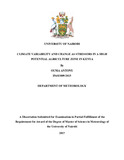| dc.description.abstract | Climate variability and change are intensifying extreme weather events, making developing
countries more vulnerable to the consequences of climate change because of overdependence
on natural resources for livelihood. The effects of climate change and variability will
probably affect the potential of a high potential agro-ecological area in Kenya.
The main objective of this study was to evaluate the effects of climate change on moisture
and thermal resources of Kenya’s high potential agriculture zone and account for climate
change induced stress for crop suitability assessment. Daily minimum, maximum, dew point
and mean temperatures, rainfall, and wind speed data for the period 1985-2014 from Kitale,
Kericho, Kakamega, Kisii, and Eldoret stations were used.
Seasonal and Trend decomposition using Loess method, Mann-Kendall trend test, Penman-
Monteith Model, ClimPACT, and Simple Water Balance model, and climate diagrams were
used to investigate spatial and temporal differentiation of thermal and moisture regimes over
the study area.
The study established that mean, maximum, and minimum temperatures are increasing over
the five stations. Moreover, rainfall is significantly increasing over Kitale and Eldoret but
decreasing over Kakamega and Kericho and non-significant trends over Kisii. The long rains
LGPs are shortening over Kericho (2 days/year), Kakamega (2 days/year), and Eldoret (1
day/year) but lengthening over Kitale (2 days/year) and invariant over Kisii. The short rains
LGP over Eldoret were shorter but persistent at 95% confidence level. Growing degree days
also increased by over 5, 10, 10, and 11 units of cumulated heat per year over Eldoret,
Kakamega, Kericho, and Kitale respectively.
In was concluded that variability and change affect moisture and thermal resources leading to
constrained soil moisture, in case of shortening length of growing periods, and higher pest
and disease development rates due to high heat units. These constraints affect the potential of
agricultural production and hence act as stress production factors. From these findings, there
is a need for farm level technical adjustments, a financial derivative targeting crop-product
prices and a natural resource management domain. | en_US |



